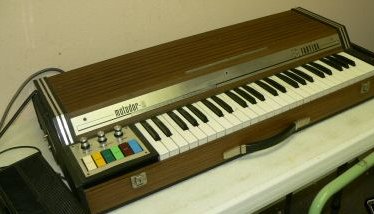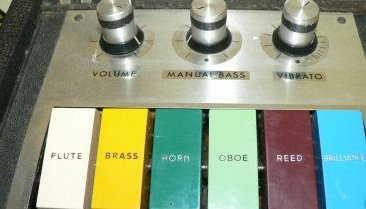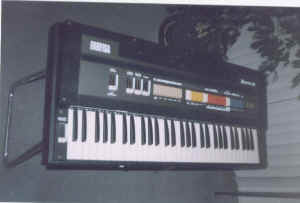Farfisa: Others
Just a collection of other models that didn't fit anywhere else (well,the Matador could have been stuck in with the VIP's, I guess).
Matador
Model No: 611
Controls:
Manual Bass: Bass
Attack
On
Treble: Flute
Brass Horn
Oboe Reed
Brilliance
Percussion: On Phrasing
Decay Repeat
Vibrato: Speed
Delay
Repeat Speed (knob)
Rear Panel Jacks: Ext. Amplif., Slalom, Headphone
Matador-R
Identical to the Matador 611, but with the addition of a Rhythm unit
Model No: 611/R
Controls: Same as the Matador
Rhythm Unit Controls: (ahhh, who cares?)
Matador-M:



Controls:
Knobs: Volume, Manual Bass, Vibrato
Voice Tabs: Flute
Brass Horn
Oboe Reed
Brilliance
Matador-A
Controls:
Accomp: Soft/Loud
Bass Chords/Manual Bass
Wah-Wah:
Off/On
Vibrato: Slow/Fast
Off/On
Voice Tabs: Flute
Brass Horn
Oboe Reed
Brilliance
Commander
(Thanks to Dirk for the great pictures)
 This picture is courtesy of
Carlos (owner of the Spanish combo organ yahoo group - URL is in the
picture). Note that the stand is just like the one for the Bravo.
This picture is courtesy of
Carlos (owner of the Spanish combo organ yahoo group - URL is in the
picture). Note that the stand is just like the one for the Bravo.
Controls:
Tabs:
Pedalboard: Bass, Sustain, Bass Guitar, Trombone
Lower M.: Flute, Clarinet, Reed
Upper M: Flute 16', Flute 8', Flute 4', Clarinet 16' Oboe 8',
Piccolo 4'
Vibrato: Vibrato On, Vibrato Fast, Vibrato Delay
Wah Wah
Buttons:
Mono Section: Cancel, Trombone, Sax, Clarinet, Harmonica,
Violin, Piano, Attack
Sliders:
Volume: Pedal, Lower M., Mono
Sustain, Reverb
Buttons on front, below keyboard: M, 7th
Owner "Dirk" offers the following commentary: "for
me the commander sounds like a vip205 look a like. the sound possibilities are
less than on the vip, but the accomp and rhythm unit is big fun with elektro
harmonix effects! ;-) the connector for the bass pedal is strange. looks like a
small scsi-adaptor."
Bravo
Controls:
Sliders:
General Volume, Bass Volume, Rhythm Volume, Tempo
Accompaniment Tabs:
Bossa Nova, Rock, Disco, Swing, March, Waltz
Key Start, Easy Chord, Memory, On
Treble Tabs:
Flute, Brass, Horn, Reed, Strings, Wah-Wah
Vibrato Tabs:
On, Fast
Attack Tab: On
Buttons Below Keyboard: m, 7th
Super Bravo
Thanks to Melbourne Music for the pics of the Super Bravo. Here's their typically entertaining description:
"Born in 1971 and raised on a diet of psychedelia, this is the musical equivalent of a large block of Gruyere. The ubiquitous rocker tabs surface once again in shades of Yellow, Red, Cornflour Blue, Regal Blue and Ivory, proving beyond a doubt that the visually challenged were not just restricted to Eastern design studios.A similar (almost identical), complement of voices to the Japanese entries, with the addition of a dedicated WhaWha tab.(Oh yeah, this is Really Useful!)Control is via slide pots (Hey.1971, remember?), and includes controls for a rhythm section. Rhythm? -Yes!..Bonus! Really Useful feels like Swing, March, Waltz-who could ask for anything more. But more there is...Attack-(the dumbest percussion ever heard),Auto Chord function with dedicated Minor and 7th buttons ,and another tab called Free Bass, which is probably for those really Hot Richard Pryor sounds. But wait!..forget the free set of steak knives, this unit comes with it's own integral amp and speakers.Casiotone eat your heart out!"
Bravo 61
 This one is a bit fuzzy, but it's larger, and you can see some of the markings a
bit better. Still can't quite make out the tab names, though.
This one is a bit fuzzy, but it's larger, and you can see some of the markings a
bit better. Still can't quite make out the tab names, though.